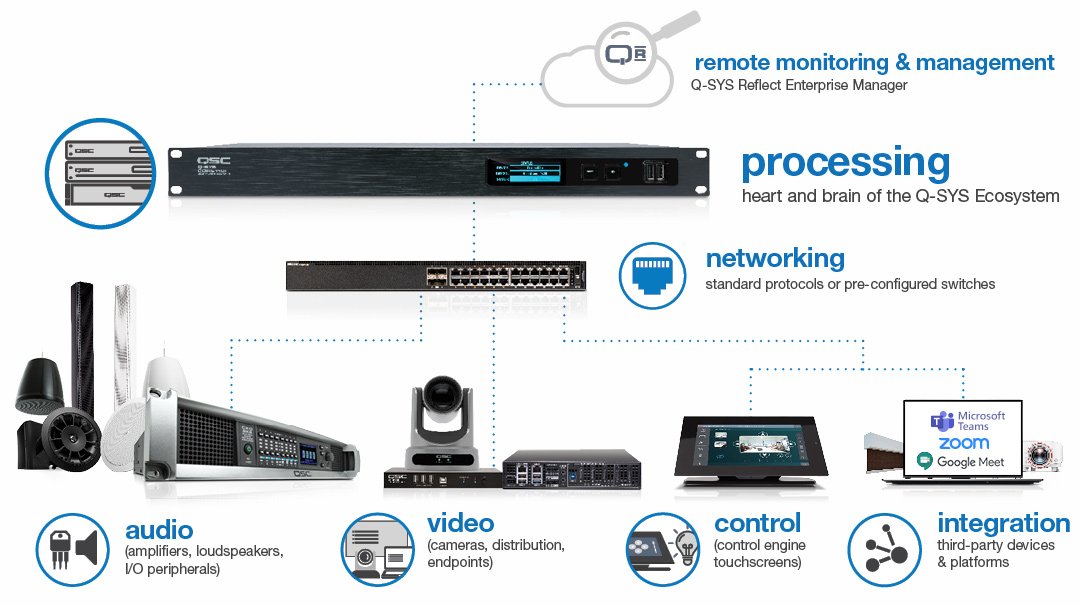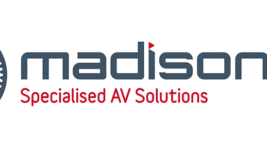News
21 Sep 2021
Q-SYS Certified for Teams

Subscribe to CX E-News
QSC has expanded its portfolio of Microsoft Teams Rooms certified meeting room accessories with the addition of several new Q-SYS products.
This completes the certification of its existing portfolio of collaboration devices for high-value spaces, including classrooms, executive boardrooms, divisible rooms, flexible spaces, immersive video conferencing rooms, and training spaces.
The certified solutions include additional Q-SYS Core processing options, the Core 8 Flex, Core Nano, and NV-32-H (Core Capable), which provides more options to rightsize processing needs for a particular room size and I/O requirements. For video camera streams, the certified Q-SYS PTZ-IP conference cameras integrate with the Q-SYS Cores or newly certified Q-SYS I/O-USB Bridge to deliver professional-quality conference feeds, as well as the unique ability to add multiple conference cameras for a more natural, inclusive engagement for remote web conferencing participants. In addition, users can utilise the newly certified CX-Q Series for additional amplification options.
“We understand high-value spaces require enhanced capabilities and features to effectively deliver a flexible and scalable video conference experience,” says Jason Moss, Vice President of Alliances & Ecosystem, QSC. “As we continue to invest in our relationship with Microsoft for our ever-growing portfolio, we are pleased to provide integrators and IT end users with additional Q-SYS options to deploy the experience in these rooms.”
Like the other QSC Teams Rooms certified solutions, users can take advantage of QSC software innovations to help simplify the integration process, enable full room control and Teams Rooms control over online meetings onto a single device, and unify the experience for the end user.
“For the System Integrator, investing the time to learn Q-SYS makes perfect sense because that knowledge is scalable across every size of installation, from restaurant, to theme park, and everything in between,” says Giles Brading, head of the QSC business unit at Australian distributor, Technical Audio Group.
Created from the ground-up, Q-SYS is a software-based platform built around an open IT-friendly ecosystem. It uniquely leverages the power of Intel processing, the robustness and mission critical reliability of a Linux operating system, and the interoperability of IEEE networking standards.
This IT-centric layered approach allows QSC to easily migrate the Q-SYS Ecosystem to other Intel platforms as they introduce new, faster chipsets, and other commercial off-the-shelf hardware. Furthermore, its usage of IT standard protocols makes the Q-SYS Ecosystem highly extendable for future IT functions and platforms.
A single Q-SYS Core processor, such as the Core 110f, can handle nearly any small to medium installation in hospitality, venues, education, houses of worship, retail, or fitness studios, etc. It includes local inputs and outputs, audio and control processing, video conference camera routing, USB endpoint bridging, audio players and recorders, advanced echo cancellation processing, EQ and more.
For bigger and more complex systems the option is to cookie-cutter each room or group of rooms with a series of Core 110fs, with Core-to-Core streaming if necessary, or employ a single Enterprise Core, such as the Core 5200, with the power and channel count for the whole system.
Typically, mega systems like company-wide business or campus-wide education, stadiums, transportation terminals, theme parks, or cruise ships will deploy audio, video and control (AV&C) processing from the data centre with an Enterprise Core. This concept allows IT to centralise all processing, control and monitoring of every piece of technology in the entire system, while offering full redundancy on nearly every Q-SYS component, just as you would for any other IT service on their network. This is the full experience of AV/IT convergence!
Coming back to scalability, Q-SYS is scalable both vertically and horizontally. Vertically in the sense of system size, from mini to mega, from Core Nano to Core 5200, but also horizontally as the Q-SYS ecosystem expands into video and control. Whereas Q-SYS was first launched as audio DSP the vision was always to expand horizontally and now includes video, cameras, touchscreens plus the capability to control it all plus 3rd party devices. Effectively if a device is IP controllable, Q-SYS can control it: network microphones, lighting systems, projectors, screens, blinds, cameras, coffee ordering and so on.
Subscribe
Published monthly since 1991, our famous AV industry magazine is free for download or pay for print. Subscribers also receive CX News, our free weekly email with the latest industry news and jobs.






